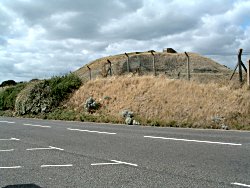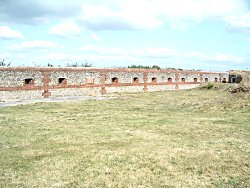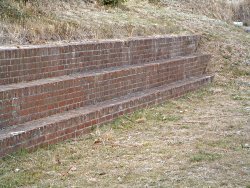EASTNEY FORT EAST
To the east of the Royal Marines Museum car park, adjacent to the Esplanade, lies Eastney Fort East. Almost hidden behind high ramparts, the fort is not normally open to the public and has as a result largely passed from the memory of most Portmuthians.
Construction of the fort began in June 1861 as one consequence of a Royal Commission in 1859 which recommended the strengthening of the Portsmouth defences. It is therefore one of the ring of structures around Portsea Island which includes the Palmerston Forts on Portsdown Hill and the Sea Forts at Spithead. Eastney Fort East and it's companion Eastney Fort West at the other side of the Barracks were built to replace the original Eastney Fort and were designed to protect the approaches to Langstone Harbour as well as cover the water between Portsea Island and Horse Sand Fort. Their construction pre-dated Eastney Barracks by a couple of years but the land on which all three structures stood had been owned by the Ministry of Defence from 1860, as an extant boundary stone confirms.
Although far smaller than any of the Portsdown Hill forts, it is nevertheless a fully fortified unit, the only major difference with it's larger cousins being the absence of any sleeping accommodation for the soldiers manning the fort. On the east and west sides there are deep, dry gorges whilst the rear was closed by a loopholed wall three feet thick. A covered way ran between the two forts, but much of this was removed during World War 2. The remaining section can be seen at the back of the Museum car park, whilst on the side facing the barracks a firing step is still evident.
The earliest record of the armaments at the forts dates from 1869 when it was stated that five 7" breech loading guns and two guns en-barbette were in place. These would not have been large enough to deter large ships in deep water off Spithead but were more than adequate for defending against small ships and raiding parties. By the 1890s, the fort had three 64 pounder, rifled muzzle loading guns with ranges up to 3,500 yards, but these were removed around 1900 and replaced by 6" breech loading guns on hydro-pneumatic carriages which had a range of 8,800 yards. These were the so-called "disappearing guns" which used the recoil to propel the gun barrel well below the parapet so that it could be reloaded in safety.
Records also tell us that the Artillery Volunteers manned the forts from an early date and that by 1889 they had been replaced by the 1st City of London Artillery Volunteers. This is perhaps surprising given that the Royal Marine Artillery were housed in the Barracks a few yards away. In an emergency the Marines could have manned the guns and in any case would have been ready to defend the covered way. Of course, neither the Marines nor the Volunteers were ever called upon to put their expertise to the test as tension with France quickly subsided. There is no evidence that the forts were used at all during the First World War and by 1936 they were handed over to the Royal Navy.
The Restoration of Eastney Fort East
In recent years, the Palmerston Forts Society in conjunction with the Royal Marines Museum, have begun a programme of restoration at the fort which fortunately had retained most of it's original structure. They have already (2009) returned two gun embrasures on the east side to a condition that would surely have been recognised by the artillerymen of the 1860s and have plans to install some contemporary guns, including a Disappearing Gun which is being repatriated from Hong Kong. It is hoped that when restoration is sufficiently advanced that the fort may be let out for local events.
Images from Eastney Fort East






